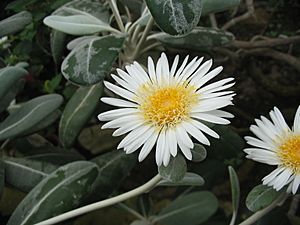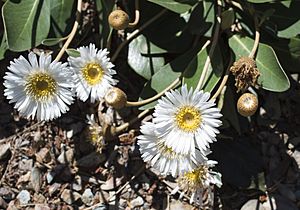Marlborough rock daisies facts for kids
Quick facts for kids Marlborough rock daisies |
|
|---|---|
 |
|
| Pachystegia insignis | |
| Scientific classification | |
| Kingdom: | |
| (unranked): | |
| (unranked): | |
| (unranked): | |
| Order: | |
| Family: | |
| Tribe: |
Astereae
|
| Genus: |
Pachystegia
Cheeseman
|
Pachystegia is a group of special shrubs, also known as Marlborough rock daisies. They belong to the daisy family. These plants have unique thick, leathery leaves and pretty daisy-like flowers. You can only find them growing naturally in dry areas of the north-eastern South Island of New Zealand.
Contents
Understanding Marlborough Rock Daisies
Scientists use a system called taxonomy to name and group living things. This helps us understand how different plants and animals are related.
How Pachystegia Got Its Name
The Pachystegia plant was first described by a scientist named Joseph Dalton Hooker in 1855. He found it near the Waihopai River in Marlborough. At first, he thought it was part of the Olearia genus, which includes other tree daisies. He named it Olearia insignis.
Later, in 1915, Thomas Frederic Cheeseman found a smaller version and called it O. insignis var. minor. Eventually, Cheeseman realized this plant was very different from other tree daisies. So, he decided it needed its own special group, or genus. He named it Pachystegia. This name means "thickly covered," which refers to the dense, fuzzy hairs found on the underside of its leaves.
Scientists have since studied these plants more closely. They now believe there are at least six different types of Pachystegia. Some of these types have been officially named, while others are still being studied.
Named Species of Pachystegia
Here are the main species that have been officially named:
- Pachystegia insignis (Hook.f.) Cheeseman
- Pachystegia minor (Cheeseman) Molloy
- Pachystegia rufa Molloy
What Marlborough Rock Daisies Look Like
Pachystegia plants are very good at living in dry places. They grow on dry hills inland and on cliffs along the coast. You often find them on rocky cliffs that are hard to reach. This helps protect them from animals like sheep, goats, and rabbits that might eat them.
These plants are low-growing shrubs that spread out. Their leaves are thick and feel leathery. The underside of their leaves is covered in white, soft fur. Their white daisy flowers start as large, unique buds. These buds are covered with many overlapping scales.
Sometimes, different types of Pachystegia can mix together and create new kinds of plants. Some of these mixed types, especially from P. insignis and P. minor, are popular garden plants around the world.
Where Marlborough Rock Daisies Live
All Pachystegia species are endemic to New Zealand. This means they are found only in the Marlborough and North Canterbury regions of the South Island.
Pachystegia insignis is the most common type. You can find it from the Wairau River in the north all the way to the Waiau River in Canterbury.
Other species, like P. rufa and P. minor, live in much smaller areas. P. minor is even considered a threatened species, meaning it's at risk of disappearing.
While many Pachystegia plants grow along the coast, some are found further inland. You can see them in places like Molesworth Station and the Upper Awatere River valley. The most endangered type is the Ōhau rock daisy. This is a species that hasn't been officially named yet, and it's only found at Ōhau Point, north of Kaikoura.
See also
 In Spanish: Pachystegia para niños
In Spanish: Pachystegia para niños


